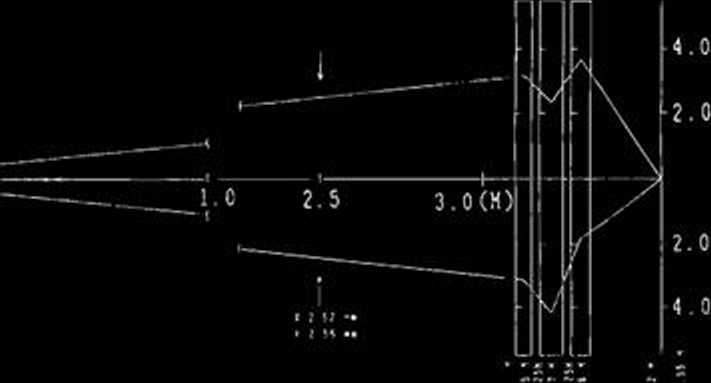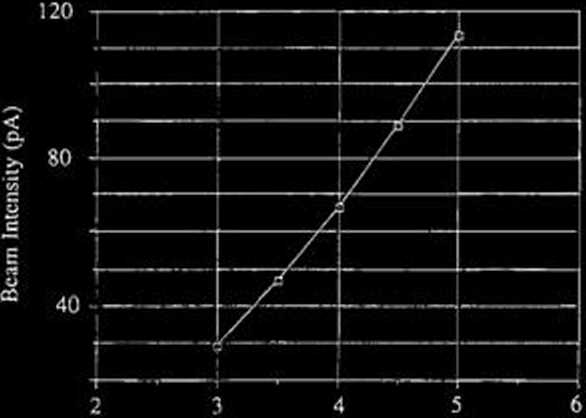372596137
92
RIKEN Accel. Próg. Rep. 24 (1990)
111-5. Instrumentation
1. Design of a Microbeamline for a Compact Cyclotron
N. Nakanishi and H. Y. Yoshida1
— «N> <“> O O O
l*« II ••
2 (U 41 M *•
* • v| »•» M ••
» #»!*>•!

Fig. 1. Beam envelopes in horizontal and vertical planes.
As extensions of the particie induced X-ray emission analysis (PIXE) and the Rutherford backscattering spectrometry (RBS), which have been extensively used as typical ion beam analysis methods, a micro PIXE and an RBS become morę popular recently because of their high space resolution. The installation of microbeam-lines have been required in many facilities.0
A microbeamline was designed for 1.8 MeV protons and 7.2 MeV alpha particles from the compact cyclotron produced by JSW. The goal of the design was to obtain a beam intensity of 100 pA in a beam spot size of 10//mx 10//m under constrains (1) the whole length of the system was less than about 3500 mm, and (2) the work-ing space between the last element and the target was morę than 200 mm.
So far, a number of microbeamlines have been constructed in many research laboratories; how-ever few microbeamlines were constracted for cyclotron beams. It is mainly due to the difficulty for using poor ąuality beams from cyclotron relative to that from electrostatic acceleraters.
Before the calculation we measured horizontal and vertical emittances of proton and alpha beams from the cyclotron to know the relation between the resultant beam emittance and the intensity included in phase ellipses. We then surveyed a magnet setting possibility to satisfy the present goal by first-order ion optics calcula-tions. The ion optics Computer codę TRANSPORT was used.2)
With a quadrupole doublet, the desirable demagnification factors could not obtained. Because of the poor emittance of the beams, resultant intensity was much lower than required. In order to realize the goal, we inves-tigated Systems composed of three quadrupole magnets. A large acceptance being indispensable for the system, it was difficult to get smali 2nd-order intrinsic aberrations. In order to get the lst-order abberation coefficients as smali as possible, we used a triplet consisted of quad-rupole magnets with a different effective length and a different field gradient. The field gradient of these quadrupole magnets was set to be less than 3 KG/cm in view of technical considera-tions. Calculated beam envelopes in horizontal and vertical planes are shown Fig. 1. The objec-tive aperture is formed by two pairs of slits and beams are defined by subsidiary slits at 2.5 m
S 2. Oh
oc o 5C
•t
O
-4.01
£

Half Width of Yertical Beam Spoi (nm)
Fig. 2. Expected beam intensity as a function of their vertical half width a of beam spot at a target.
from the object point. Figurę 2 shows the beam intensity as a function of the yertical half width of the beam spot at the target position. We obtain a result that the beam intensity is 100 pA in a beam spot of 8.5 //m(H)x9.2 //m(V). The whole length of the system and the image dis-tance are 3550 mm and 220 mm, respectively. The specification of the beamline are summarized in Table 1, and the layout of the system is shown in Fig. 3. The beamline will be completed by the end of 1990.
Japan Steel Work Ltd. (JSW).
Wyszukiwarka
Podobne podstrony:
103 RIKEN Accel. Próg. Rep. 24 (1990)111-5-9. Test Experiment of the GARIS/IGISOL K. Morita, T. Nomu
116 RIKEN Accel. Próg. Rep. 24 (1990)111-5-19. Responses of Large Position-Sensitive Detectorsto Hea
11 RIKEN Accel. Próg. Rep. 24 (1990)111-1-2. Three a Disintegration of 12C in the Field of208Pb Nucl
63 RIKEN Accel. Próg. Rep. 24 (1990)111-2-28. Development of Nuclear Track Microfilters N. Nakanishi
72 RIKEN Accel. Próg. Rep. 24 (1990)111*3-8. Dry Separation of Radioactive Nuclides from a Gold Targ
80 RIKEN Accel. Próg. Rep. 24 (1990)111-3-16. Development of an lon Beam Sputtering Method toPrepare
63 RIKEN Accel. Próg. Rep. 24 (1990)111-2-28. Development of Nuclear Track Microfilters N. Nakanishi
94 RIKEN Accel. Próg. Rep. 24 (1990)111-5-2. Design of a Decay Muon Channel Using an Axially Symmetr
102 RIKEN Accel Próg. Rep. 24 (1990)111-5-8. Performance of Isotopic Separation in RIPS T.Nakamura,
105 RIKEN Accel. Próg. Rep. 24 (1990)111-5-10. Velocity Distribution of IGISOL lon Beams M. Koizumi,
108 RIKEN Accel. Próg. Rep. 24 (1990)111-5-12. Status Report of the RIKEN Swinger-Magnetic Analyzer
110 RIKEN Accel. Próg. Rep. 24 (1990)111-5-14. Test for Dispersive-Mode Beam Transportto the SMART
RIKEN Accel. Próg. Rep. 24 (1990)111-5-25. High Speed Serial Data Link for PC-9801 J. Fujita > PC
więcej podobnych podstron